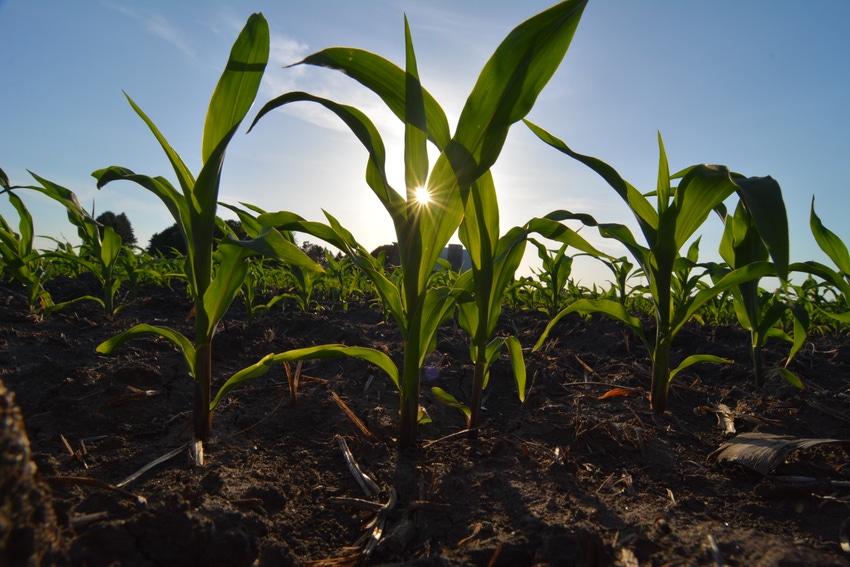January 16, 2018

Think Different
Depending on the state, marestail, waterhemp, giant ragweed, pigweeds, lambsquarter, velvetleaf, kochia and more continue to frustrate farmers. And most of these resist multiple herbicides.
Farmer success comes from effective herbicide resistance management: rotating crops, timely applications, multiple effective modes of action, confirming control before planting, and using the correct adjuvants.
Farmers should first consider what weeds they have in each field. Know when they emerge. Know what control methods have and haven’t worked. Then build a weed management strategy that includes at least three different modes of action and the proper adjuvant to maximize their effectiveness. Lastly, fine tune your application techniques for these unique modes of action.
Pursue the weed control advantages with cover crops, as this can be an important tool in your toolbox.
Overlapping residual weed control, less reliance on post spraying, multiple modes of action applied, proper adjuvant use and learning the details of seed-herbicide systems are among the issues highlighted by WinField United agronomists from eight Midwest states. They offer great insight on weed resistance, what worked in 2017, and how to prepare for 2018.
While cover crops were not addressed by these agronomists, more farmers are learning how to improve weed control with these important soil builders. This practice should be considered another tool to stop weeds.
Beat herbicide-resistant weeds
Herbicide resistant weed issue continues to grow across the Midwest. Depending on the state, marestail, waterhemp, giant ragweed, pigweeds, lambsquarter, velvetleaf, kochia and more continue to frustrate farmers.
In Indiana, glyphosate-resistant marestail and amaranthus species (pigweeds, Palmer amaranth) were the two most challenging weeds, says Indiana WinField United agronomist Glenn Longabaugh.
Marestail was largely a problem in no-till fields, but farmers who made a fall or early spring burndown saw the most success. For amaranthus species, farmer success came from effective herbicide resistance management: rotating crops, timely applications, multiple effective modes of action, confirming the kill before planting, and using the correct adjuvants to make the active ingredient more likely to kill problematic weeds.
Iowa farmers had a tough time controlling giant ragweed, waterhemp and marestail, says Tyler Steinkamp, Winfield United agronomist. Both the Xtend and Liberty systems were effective on these weeds in soybeans. Residual control products were often used in conjunction with a post herbicide application, and some farmers switched to 15-inch rows for quicker canopy cover in soybeans.
Regarding weed resistance, Steinkamp says both glyphosate and PPO inhibitors often failed to control waterhemp. The big takeaway for farmers is to think holistically, about seed purchases in conjunction with choosing herbicides.
Glyphosate-resistant marestail was also big problem in Michigan in 2017, says WinField United agronomist Jason Roth. The weed had been an issue in Ohio, Indiana and southern Michigan, but traveled north in the state and flourished this season. Other troublesome weeds included waterhemp (also glyphosate-resistant) and lambsquarters.
Shift from post mindset
Treating marestail in soybeans postemergence is difficult, since the weed is not only glyphosate-resistant, but ALS-resistant as well, says Roth. He advised farmers to live with marestail this year and approach weed management differently -- by not relying on controlling weeds postemergence. Instead, start with clean fields in the spring. Controlling lambsquarters was also tricky, as the summer was cool with lots of cloud cover, and glyphosate tends to work better when conditions are sunnier, he adds. Waterhemp can be managed if an effective soil residual herbicide is used, he says. Farmers need to shift mindsets and practices to be far less reliant on controlling weeds after they emerge.
In west-central Minnesota, glyphosate-resistant waterhemp was the dominant weed in 2017, along with giant and common ragweed, says Mark Glady, regional agronomist for WinField United. Farmers realize it is nearly impossible to eliminate waterhemp in soybeans once the weed has emerged, and that using multiple passes of residual herbicides is optimal.
Ohio farmers continue to battle marestail and now waterhemp, says Joe Rickard, regional agronomist for WinField United. Farmers used a residual pre-burndown herbicide and/or used XtendiMax or Liberty herbicides postemergence for control.
To help combat kochia and marestail in South Dakota, farmers began spraying earlier than normal. Often it took more than one application, if they could be controlled at all, reports Kyle Gustafson, agronomist for WinField United.
Three modes of action needed
As for waterhemp, Gustafson recommends incorporating in-season residual products. He says row cultivating may have to be an option in some operations. With continuous weed resistance issues, he says herbicide timing and modes of action are everything. It takes at least three effective modes of action, such as a preemergence herbicide, a postemergence herbicide and a residual application, to control herbicide-resistant weeds.
The most challenging weeds in Wisconsin this year were velvetleaf and late-season waterhemp, reports Jon Zuk, Winfield United agronomist. Many farmers addressed these pressures through varying modes of action combined with proper adjuvant selection. Zuk took samples of weeds that were suspected to be resistant and tested them. Based on the results, he worked with farmers to outline appropriate weed management plans for next year.
Learning dicamba
New products often come with challenges, which is true for the new dicamba herbicides. Label instructions are extensive and highly detailed, so farmers should take advantage of training opportunities and take the time to understand proper tank-mix protocol and application processes. Doing so will help them achieve the most success with the product, says Joe Rickard, regional agronomist for WinField United in Ohio.
When it came to using new dicamba products, education was everything this season. WinField United created technical bulletins and educational materials for its retailers and farmers. It also took part in research studies to give retailers and farmers access to data and resources about what products could help them best follow the label. Zuk says leaning on a trusted advisor for guidance is an essential part of dicamba management.
Roth stresses that label directions must be followed precisely, and he and other agronomists worked to inform farmers about correct nozzle selection, approved tank mixes and application methods throughout the year. He also encourages farmers to use the appropriate adjuvant to help control drift and get more herbicide to the intended target.
Steinkamp says he frequently reminded farmers to check label requirements online before making any dicamba applications. Along with that, being aware of what’s upwind, paying attention to buffer strips and ensuring a clean tank after making applications is essential when using these products.
Strategies for 2018
As the new season approaches, Illinois WinField United agronomist Sara Smelser reminds farmers to begin planning their 2018 weed management strategy. Staying up to date on new regulations (including required trainings for Restricted Use Pesticides), utilizing multiple modes of action and incorporating adjuvants are all key components of a successful strategy.
Longabaugh notes that regardless of commodity prices, those who had weed issues this year should rotate their crop. Farmers are also encouraged to use multiple effective modes of action, apply residual herbicides and confirm weeds are controlled before planting the crop. A little bit of spend upfront with sequential preemergence applications will save farmers from having to use more expensive and less effective postemergence applications.
Steinkamp says farmers should proactively consider what weeds they will struggle with in 2018, then go after these predicted weeds correctly the first time. Weeds come back stronger the second time around, he says. While it’s important to consider new technologies to take down weeds, he reminds farmers not to forget about more established options. Liberty is an older, yet effective technology that weeds haven’t shown resistance to in Iowa. And he adds that spray clinics at local retail locations will be an important resource for farmers this year.
Decide herbicide system
In planning for 2018, Glady says there are a number of factors to consider for each Roundup, Liberty or a dicamba herbicide system:
Roundup requires multiple layers of residual herbicides along with a postemergence herbicide for the most effective weed control. Using an adjuvant to help spread out spray droplets in order to get more herbicide into the plant is very important.
Liberty herbicide works best with hot, sunny days, flat-fan nozzles and extra management, says Glady. Using an adjuvant is also important here, because without one, Liberty is not going to work to its full potential and weeds will likely be missed, he notes.
Farmers must decide which herbicide system fits their comfort level and helps them achieve their yield goals, says Glady. Once that is determined, they can then choose the right adjuvants, the right residual herbicides and other elements to formulate a comprehensive weed-control program for 2018.
Gustafson says farmers should keep three weed management practices in mind. First, if its an early spring, spray early and often to address weed pressures. Second, spray weeds before they are the height of a beer can, which is about four inches tall. Third, don’t skimp on the adjuvants. An adjuvant is just as important as the herbicide itself and can be the difference between good and excellent weed control.
Know weed biology
Zuk encourages farmers first and foremost to consider what the weed spectrum is for their crop. What weeds do they have in the field? When do those weeds emerge? What methods of control have and haven’t worked in the past? What are farmers’ spraying habits or patterns?
From there, he recommends laying out a weed management strategy that includes at least three different modes of action and the proper adjuvant to maximize their effectiveness. Lastly, farmers should consider application techniques for these unique modes of action. Decisions such as nozzle selection, as well as application rates and timing, should be fine-tuned. Adequate weed control probably won’t be achieved with postemergence herbicide applications alone. He encourages farmers to be proactive and to use a preemergence herbicide to help prevent weed emergence for as long as possible.
About the Author(s)
You May Also Like






